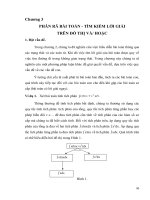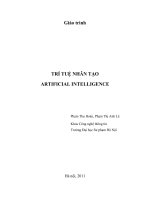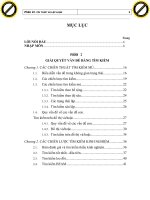Slide trí tuệ nhân tạo adversarial search
Bạn đang xem bản rút gọn của tài liệu. Xem và tải ngay bản đầy đủ của tài liệu tại đây (1.28 MB, 36 trang )
Introduction to
Artificial Intelligence
Chapter 2: Solving Problems
by Searching (6)
Adversarial Search
Nguyễn Hải Minh, Ph.D
CuuDuongThanCong.com
/>
Outline
1.
2.
3.
4.
Games
Optimal Decisions in Games
α-β Pruning
Imperfect, Real-time Decisions
06/05/2018
Nguyễn Hải Minh @ FIT
CuuDuongThanCong.com
2
/>
Games vs. Search Problems
❑Unpredictable opponent
→specifying a move for every possible opponent
reply
❑Competitive environments:
→ the agents’ goals are in conflict
❑Time limits
→unlikely to find goal, must approximate
❑Example of complexity:
o Chess: b=35 , d = 100 ➔ Tree Size: ~10154
o Go: b=1000 (!)
06/05/2018
Nguyễn Hải Minh @ FIT
CuuDuongThanCong.com
3
/>
Types of Games
Deterministic
Perfect
Chess, Checkers, Go,
information Othello
Imperfect
information
06/05/2018
Chance
Backgammon
Monopoly
Bridge, poker,
scrabble nuclear
war
Nguyễn Hải Minh @ FIT
CuuDuongThanCong.com
4
/>
Types of Games
06/05/2018
Nguyễn Hải Minh @ FIT
CuuDuongThanCong.com
5
/>
Primary Assumptions
❑Assume only two players
❑There is no element of chance
o No dice thrown, no cards drawn, etc
❑Both players have complete knowledge of the state of
the game
o Examples are chess, checkers and Go
o Counter examples: poker
❑Zero-sum games
o Each player wins (+1), loses (0), or draws (1/2)
❑Rational Players
o Each player always tries to maximize his/her utility
06/05/2018
Nguyễn Hải Minh @ FIT
CuuDuongThanCong.com
6
/>
Game Setup (Formulation)
❑Two players: MAX and MIN
❑MAX moves first and then they take turns until the game is over
o Winner gets reward, loser gets penalty.
❑Games as search:
o S0 – Initial state: how the game is set up at the start
• e.g. board configuration of chess
o PLAYER(s): MAX or MIN is playing
o ACTIONS(s) – Successor function: list of (move, state) pairs
specifying legal moves.
o RESULT(s, a) – Transition model: result of a move a on state s
o TERMINAL-TEST(s): Is the game finished?
o UTILITY(s, p) – Utility function: Gives numerical value of terminal
states s for a player p
• e.g. win (+1), lose (0) and draw (1/2) in tic-tac-toe or chess
06/05/2018
Nguyễn Hải Minh @ FIT
CuuDuongThanCong.com
7
/>
Tic-Tac-Toe Game Tree
MAX uses search tree to
determine next move.
06/06/2018
Nguyễn Hải Minh @ FIT
CuuDuongThanCong.com
8
/>
Chess
❑Complexity:
o b ~ 35
o d ~100
o search tree is ~ 10154 nodes (!!)
→completely impractical to search this
❑Deep Blue: (May 11, 1997)
o Kasparov lost a 6-game match against IBM’s Deep Blue (1
win Kasp – 2 wins DB) and 3 ties.
❑In the future, focus will be to allow computers to LEARN
to play chess rather than being TOLD how it should play
06/06/2018
Nguyễn Hải Minh @ FIT
CuuDuongThanCong.com
9
/>
Deep Blue
❑Ran on a parallel computer with 30 IBM RS/6000
processors doing alpha–beta search.
❑Searched up to 30 billion positions/move, average depth
14 (be able to reach to 40 plies).
❑Evaluation function: 8000 features
o highly specific patterns of pieces (~4000 positions)
o 700,000 grandmaster games in database
❑Working at 200 million positions/sec, even Deep Blue
would require 10100 years to evaluate all possible games.
(The universe is only 1010 years old.)
❑Now: algorithmic improvements have allowed programs
running on standard PCs to win World Computer Chess
Championships.
o Pruning heuristics reduce the effective branching factor to
less than 3
06/06/2018
Nguyễn Hải Minh @ FIT
CuuDuongThanCong.com
10
/>
Checkers
❑Complexity:
o search tree is ~ 1018 nodes
→requires 100k years if solving 106 positions/sec
❑Chinook (1989-2007)
o The first computer program to win the world champion
title in a competition against humans.
o 1990: won 2 games in competition with world champion
Tinsley (final score: 2-4, 33 draws)
o 1994: 6 draws
❑Chinook’s search:
o Ran on regular PCs, used alpha-beta search.
o Play perfectly using alpha-beta search combining with a
database of 39 trillion endgame positions.
06/05/2018
Nguyễn Hải Minh @ FIT
CuuDuongThanCong.com
11
/>
GO
1 million trillion trillion
trillion trillion more
configurations than chess!
❑Complexity:
o Board: 19x19 → Branching factor: 361,
average depth ~ 200
o ~ 10174 possible board configuration.
o Control of territory is unpredictable until the endgame.
❑AlphaGo (2016) by Google
o Beat 9-dan professional Lee Sedol (4-1)
o Machine learning + Monte Carlo search guided by a “value
network” and a “policy network” (implemented using deep
neural network technology)
o Learn from human + Learn by itself (self-play games)
06/06/2018
Nguyễn Hải Minh @ FIT
CuuDuongThanCong.com
12
/>
Optimal Decision in Games
❑In normal search problem:
o Optimal solution is a sequence of action leading to a
goal state
❑In games:
o A search path that guarantee win for a player
o The optimal strategy can be determined from the
minimax value of each node
For MAX
06/05/2018
Nguyễn Hải Minh @ FIT
CuuDuongThanCong.com
14
/>
A two-ply game tree
MAX best move
MIN best move
Utility values for MAX
06/05/2018
Nguyễn Hải Minh @ FIT
CuuDuongThanCong.com
15
/>
Minimax Algorithm
❑John von Neumann devised a search technique,
called Minimax
❑You play against an opponent
o Your objectives are in direct opposition
o MAX tries to maximize his play while trying to
minimize his opponent’s (MIN’s) play
❑To implement Minimax, you need to know how
good (or bad) your position is.
o That is called the Utility function
06/05/2018
Nguyễn Hải Minh @ FIT
CuuDuongThanCong.com
16
/>
Minimax Algorithm
❑Definition of optimal play for MAX assumes MIN
plays optimally:
o maximizes worst-case outcome for MAX
❑But if MIN does not play optimally, MAX will do
even better
❑Minimax uses depth first search to traverse the
game tree
o Complete depth-first exploration of the game tree
06/05/2018
Nguyễn Hải Minh @ FIT
CuuDuongThanCong.com
17
/>
Minimax algorithm
06/06/2018
MAX best move
Nguyễn Hải Minh @ FIT
CuuDuongThanCong.com
18
/>
Properties of minimax
❑Complete?
o Yes (if tree is finite)
❑Optimal?
o Yes (against an optimal opponent)
❑Time complexity?
o O(bm)
❑Space complexity?
o O(bm) (depth-first exploration)
For chess, b ≈ 35, m ≈100 for "reasonable" games
→ exact solution completely infeasible
06/05/2018
Nguyễn Hải Minh @ FIT
CuuDuongThanCong.com
19
/>
QUIZ
Calculate the utility value for the remaining nodes.
Which node should MAX and MIN choose?
06/05/2018
Nguyễn Hải Minh @ FIT
CuuDuongThanCong.com
20
/>
Problem with Minimax Search
❑Number of game states is exponential in the
number of moves.
o Solution: Do not examine every node
→pruning: Remove branches that do not influence final
decision
❑Bounded lookahead
o Limit depth for each search
o This is what chess players do: look ahead for a few
moves and see what looks best
06/05/2018
Nguyễn Hải Minh @ FIT
CuuDuongThanCong.com
21
/>
α-β pruning
❑Idea:
o If a move A is determined to be worse
than move B that has already been
examined and discarded, then examining
move A once again is pointless.
• α: best already explored option (utility value) along
path to the root for MAX
• β: best already explored option (utility value) along
path to the root for MIN
06/06/2018
Nguyễn Hải Minh @ FIT
CuuDuongThanCong.com
22
/>
The α-β algorithm
06/06/2018
Nguyễn Hải Minh @ FIT
CuuDuongThanCong.com
23
/>
α-β pruning example
Value range of Minimax
value for MAX
Value range of Minimax
value for MIN
06/05/2018
Nguyễn Hải Minh @ FIT
CuuDuongThanCong.com
24
/>
α-β pruning example
06/05/2018
Nguyễn Hải Minh @ FIT
CuuDuongThanCong.com
25
/>
α-β pruning example
06/05/2018
Nguyễn Hải Minh @ FIT
CuuDuongThanCong.com
26
/>









